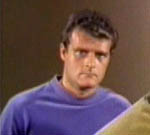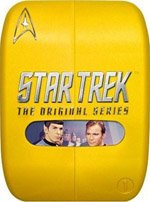Where No Man Has Gone Before

|
|
Strangely, Star Trek's first pilot didn't lead directly into a series.
Instead, it lead to this second pilot, and a second chance to sell itself
to a network according to their beliefs about what would make a great TV series.
This opened the door for some big cast changes, some for better, some for worse.
Enter William Shatner as our new Captain of the Enterprise.
In actual fact, three scripts were commissioned to compete for the job of
second pilot. Samuel Peeples' efforts eventually got the job done, with
the other two scripts turning into regular episodes of the series later on.
|
Some of the strengths of this script include its methods of introducing
audiences to the Trek universe and its population, and also that the central
figures focused on today featured compelling levels of characterization.
We also get the more standard action finish that many executives felt was missing
from the previous pilot, and there are good levels of mystery and tension
building towards this climax. But sadly, the overall premise of today's story,
though decent, really isn't all that grand or inspiring.
Kirk's Crew Picks
It truly is bizarre that this story wasn't used for the first broadcast episode
on September 8, 1966. Production Executive Herb Solow says it was felt that
this story was "too expository". Exactly how does that hold up as a reason?
If the audience is completely brand new to the Star Trek universe and its characters,
why would they not want and need that exposition? Sometimes I think those media
professionals who habitually deride exposition need some kind of wake-up call
to snap them out of their self-induced stupor. Make exposition
more exciting and gorgeous and classic if you have to, but never avoid it or
hurriedly toss it off into the corner. It's too important.
And "Where No Man Has Gone Before" does a pretty good job of focusing on exploration
first and foremost, taking us on a tour of the types of environments that
Star Trek will bring us week after week, and introducing many of the most important
characters of the series. It's not quite as good or quick at this as its predecessor
"The Cage", but it's still solid.
|
This is the story that introduces us to Captain James Kirk,
and we get some good insight into his personality and command style. Most importantly
of all, although he has clearly already met Mr. Spock before the story opens,
this tale shows how they closed the gap of their initial philosophical differences
to form a working relationship with each other... a relationship that they will
enjoy and rely on throughout the rest of the show, and throughout the rest of their lives.
That's good material for a first broadcast, and that material is a solid strength here.
|

|
It's also a development that comes as a bit of a surprise to Captain Kirk, who
initially believes that his closest confidant on this five year mission will be
his old academy buddy Gary Mitchell, played by actor Gary Lockwood who would go on
to feature as astronaut Frank Poole in
Stanley Kubrick's classic sci-fi film "2001".
The friendship between Kirk and Mitchell is played with a sense of fun and warmth
by the actors, and becomes a successful backbone against which the events of the
story take their toll.
Also making his debut in this episode is Montgomery Scott, played by James Doohan.
Scotty gets a good number of lines to say and things to do in this story, including
appearing as the Chief Engineer in the line-up of department heads. However, it is
curious to see the character of pilot Lee Kelso, played by Paul Carr, spending far
more screen time tackling engineering and technical fixes than Scotty does,
and Scotty often seems to be reporting to him. Is Kelso the real head of
engineering at first? Kelso is quite likeable,
and seems an easy shoe-in to become a regular or semi-regular.
One is tempted to keep one's eyes peeled to see if he can be spotted in any
future episodes... until, in this very episode,
he becomes the first character to die on screen in Star Trek.
Bummer. But this also gives one the impression, perhaps falsely, that Scotty's
duties were ramped up so that he could fill the gap created by Kelso's absence.
Mr. Sulu makes his debut in this episode as well - although his role here is
head of the astro-sciences department, showing off what a mathematics whiz he is,
and getting hardly any screen time or lines. Kelso's absence will benefit him
even more so than Scotty, when he takes over the pilot's position for the rest
of the series....
Falling pretty flat is Paul Fix's bland portrayal of Dr. Piper, who, to be fair,
doesn't really get a scene of any real significance in the entire show, although
it does feel as though his examination of Mitchell in sickbay has had most of its
footage sent to the cutting room floor after the fact. Is it in Vonda N. McIntyre's
novel "Enterprise: The First Adventure" where it is retroactively rationalized
that Kirk always knew he wanted his colleague "Bones" McCoy along for this mission,
but arranging McCoy's complicated transfer involved temporarily putting up
with Piper for a bit?
Yeoman Smith is another casualty of lack of attention from the script, and she
manages to have far less to do than her counterpart in the previous pilot, while
she expresses virtually no emotion whatsoever while doing it. It seems it would
have been better to not try to cast a regular yeoman until there is a script
that is prepared to use the character in some fashion.
|
Another easy to forget series regular making his debut here in this episode
is Mr. Leslie, played by Eddie Paskey. Don't remember him? Well, he's only
a background "extra" character, often seen but only heard speaking lines in
a few rare episodes, and even more rarely actually getting a credit at the end
of the show. He usually wears a red shirt while having an uncanny knack
for staying alive, but today he's in blue. He is most easily spotted on the
planet, standing outside the cell with Kirk and Spock.
|
|

|
Lastly amongst this crew is psychologist Dr. Elizabeth Dehner,
played by Sally Kellerman, a character who has a small hint of the coldness
of the previous pilot's Number One character, but who is much more emotionally
rounded in general, and even passionate about her areas of expertise.
She is also worthy of becoming a regular or semi-regular, but instead has
an important story-specific role to play as a guest star.
Astro-Sciences Reporting In
This story will squeak by with a grade of C- in astronomy. Armed with foreknowledge
of how our Milky Way Galaxy will be divided into four quadrants in future centuries
in the Star Trek universe, quadrants that take a long time to cross and remain
largely unexplored in Kirk's time, it seems a bit lax that this episode could
have Kirk casually announce that the ship will now leave the galaxy, and that upon
doing so will find it surrounded by a funky magical barrier. Perhaps we have to
think beyond the automatic impression that we get.... Perhaps we should think about
the galaxy three-dimensionally, with the Enterprise not traveling out beyond the
external edge of the galactic disc, but rather "up" or "down" beyond the plane
of the disc - a somewhat shorter and more plausible journey. It's also more
plausible if this barrier only covers a small section of the galaxy, perhaps
a few hundred light years across, somewhere far from Earth's solar system.
While the premises of "The Cage" and "Where No Man Has Gone Before" both work
well to build up a sense of the Enterprise crew digging into mysteries and
exploring unknowns, in both cases the plot uses a device perhaps best labeled
with the phrase "going where someone else HAS gone before". Both stories
get great mileage from receiving messages from those who have gone before
and had great difficulties, helping to raise the stakes and increase tensions.
In astronomical terms though, this doesn't require that the barrier surround
the entire galaxy - only that Kirk's crew should be aiming for more or less the
same spot as the previous crew, so it's manageable.
Today's planet only really comes up in the second half. Its name "Delta Vega"
feels as though it's been plucked out of the air by people who have heard
Bayer notation from astronomers, but have no idea how to put it together themselves.
A minor nit.
I'm Asking What You Know About Mind Power
This story tackles the topic of Extra-Sensory Perception, or ESP, which I thought
was quite cool and forward-looking for the time. This is actually just a springboard
to get into all kinds of mental powers in a semi-plausible way. I like that,
and I think it worked fairly well.
But the central premise falls down a bit in terms of how it remains subservient to
the predetermined dramatic arc of the episode. To me, it doesn't feel like there
is sufficient reason given for Gary Mitchell to rapidly develop towards villainy.
The best thing we actually have is the concept that his knowledge is expanding
to such profound levels, that we can truly have no concept of all the new things
filling his mind - and somewhere in that nebulous mass of new thought he has
sufficient reason.
What it really feels like is that the "smaller minds" have control over nature here.
Whatever Kirk and Spock and Kelso and Sulu fear most dictates what Mitchell
will turn into, whether that makes sense for Mitchell or not. I actually think
Anakin Skywalker's moral decline in the Star Wars prequels was more believable,
because it starts out with him simply wanting to hold on to the people he loves
and cares about, and he uses his powers to try to maintain attachments. Far more
relatable. Mitchell seems too keen to discard his relationships in this one.
To what extent are Kirk and Spock and friends forcing this choice on him
by fueling their own fears and acting on them?
And so, in a sense, this ends up being a much darker story than its predecessor
"The Cage", and has a largely down-beat ending, but for the first formative sparks
of the Kirk-Spock relationship.
The Evolution of Spock's Philosophy
The story is also one of the big anchor points for the evolutionary journey
of Spock's own philosophies. Beginning here, we will often hear Spock justify
his thoughts as being logical, without truly examining the over-arching philosophy
that his logic is used to support. At this early end of the spectrum, his logic
supports fear. Spock isn't getting emotional about his fears, but he is definitely
acting on the philosophy of fear. His concerns are the survival and protection
of himself, and his ship and shipmates, and he is prepared to go to murderous lengths
to achieve those goals. It is actually a sad place that we see him in here, where
he is really faced with the unknown, and does not greet it with the olive branch
of hope and goodwill, nor does he have faith that bright trained Starfleet officers
will maintain any loyalty to their fellow species when their abilities are
exponentially increased. But there is yet hope for Spock and he will grow.
The other end of this journey, in
the sixth feature film and
the Next Generation story "Unification",
will see him completing a total turnaround on this point, and that also
will be done with equal amounts of logic.
Production value remains high for this story as it was for the previous pilot,
re-using the difficult-to-light mountain cyclorama for the planet set,
adding new elements to the planet and the Enterprise,
including all desired special effects for laser blasts and space barriers,
and achieving a number of the all-time classic model shots for the Enterprise,
now smartly sprinkled throughout the story wherever necessary.
I particularly like the additional red highlights that have been
painted all around the bridge, bringing the colours to life in this
very important set. All very good.
Interestingly, though it seems to escape the notice
of some viewers, we actually have three uniform colours for the crew at
this point. Apart from the strong blue of the science people, Kirk is
wearing a yellow shirt that has a slight tint towards green, as do many
of the others on the crew. However, there is also a very light
"peach" coloured shirt as well, as worn by Gary Mitchell, Scotty, and
a few others. It does register nearly the same as the yellow to the
casual eye, and I think that the move to a much bolder red for the
rest of the series was ultimately a good move.
This is a very good second pilot, and it worked well and sold the series to
its first network. However, something of the essential philosophy of Star Trek
doesn't quite come through in this story. It has a somewhat less than positive
approach to humanity's ability to explore and deal with the unknown, or to appreciate
that which is different.
Thankfully, the network gave Star Trek a chance to do better, as it ordered
up a full season of episodes to follow....
Read the next Star Trek review:
"The Corbomite Maneuver"
|
|




















